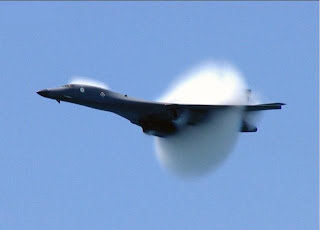When the object travels slower than the speed of sound (Ma < 1), the sound can propagate ahead of the object and an observer ahead of the object can hear the object coming before it actually arrives. In addition, the pressure pulses ahead of the object are more closely spaced than behind the object. The result is an increase in frequency of the sound ahead of the object and a decrease in frequency behind the object. This phenomenon is known as a Doppler Shift.
When the object moves at the sonic speed (Ma = 1), the pressure pulses in front of the object begin to "pile up" on one another. The locus of all the pulses in front of the object forms a line. No sound is heard in front of the object since the pressure pulses don't propagate ahead of the object. Furthermore, the infinitesimally weak pressure pulses piling up in front of the object result in a sudden and finite pressure change - a shock wave.
When the object moves at supersonic speeds (Ma > 1), the object "out runs" the pressure pulses it generates. The locus of wave fronts forms a cone which is termed a Mach Cone. The object cannot be heard outside the Mach Cone. This region is called the Zone of Silence. Inside the cone, the region known as the Zone of Action, the object can be heard. The angle that the cone makes with the horizontal is a function of the Mach number and can be determined from simple geometry

